
By SHAYLA ESCUDERO/Lincoln Chronicle
Before a white mob dragged Ichiro Kawamoto out of his home in Toledo, a battering ram pounded the door and rocks hurled down like rain.
Spectators clapped as Asian laborers and their families were forced into waiting trucks and driven to Corvallis where they were put on a train to Portland.
A century has passed since what is now called The Toledo Incident occurred on July 12, 1925. For years people didn’t talk about it. People involved didn’t tell their children. Some children grew up being told that something bad happened but their parents didn’t want to speak about it.
Others referred to it as the “Japanese story.”
People likely still wouldn’t be talking about it if Ted Cox, a Corvallis restaurant owner, hadn’t started writing down his weekly conversations with a Toledo friend.
Initially, Cox set out to write a biography about his friend. Instead, he wrote an entirely different book: “The Toledo Incident of 1925: Three days that made Oregon History in Toledo.” The book is the most comprehensive examination of how a mob forcibly expelled Asian millworkers and their families and the unprecedented civil rights case a year later when five of them laborers went to court in Portland and won.
 The Toledo Incident may have happened 100 years ago, but it isn’t an isolated incident of anti-immigration sentiment and violence in the United States. Cox and historians say it’s a repeating pattern.
The Toledo Incident may have happened 100 years ago, but it isn’t an isolated incident of anti-immigration sentiment and violence in the United States. Cox and historians say it’s a repeating pattern.
Writing a book
Roy Green loved to tell stories and Cox loved to listen. Mostly they were about Green’s life growing up in Toledo.
Cox lived in Corvallis and owned the Old World Deli. But Wednesdays were for going to the coast with Green, a Toledo native 37 years Cox’s senior. He used those car rides to write down Green’s stories.
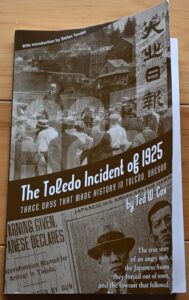
Pretty soon he had enough material to construct a biography. But he didn’t just want to write a book from Green’s recollection, he wanted to use sources to corroborate his anecdotes.
Cox kept going back to what Green called “the Japanese story.” Green was 15 when it happened. His father worked at Pacific Spruce Corp.’s mill and took his son fishing that day because he wanted to be far away when the mob chased off Asian workers and their families.
“My problem was the stuff written about it wasn’t primary sources,” Cox said.
He began doing research, mostly at the Toledo Public Library, parsing through microfiche — the rolls of film that chronicled local history through local newspapers.
“I had a mountain of information, and the Toledo Incident came out of it,” Cox said.
It was a painful history that may be difficult for some to confront. Having multiple sources was vital, so he included citations, excerpts, and an index of scanned documents.
“It was important, I knew the significance and knew it could be challenged,” Cox said.
Published in 2005, Cox’s book is the most comprehensive account of the Toledo Incident.
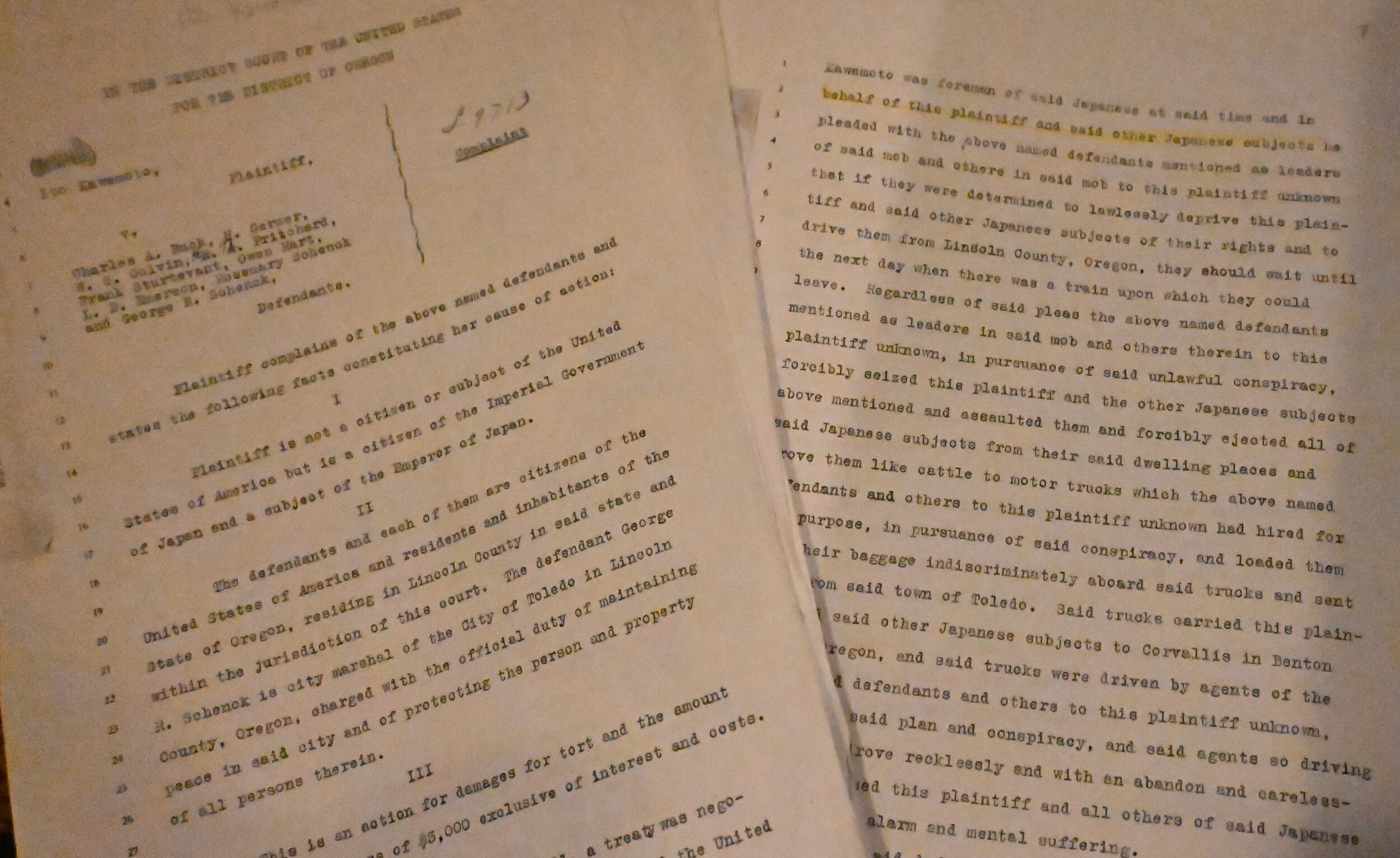
An angry mob
With one hand on the steering wheel and the other holding his open book, Cox points towards water flowing from the Yaquina River, looking across from the Port of Toledo. He looks between the book’s colorless photograph and outside the car window, certain he found the correct place. He was looking at what used to be called “Tokyo Slough.”
Cox can picture it – once there were about 20 small houses where Japanese and Asian millworkers lived. Cox collected their accounts of that day from court records, depositions and newspapers.
The day before the incident, Ito Kawamoto was walking from her home in Tokyo Slough to downtown Toledo, when she was stopped by police chief George Schenck. He told her and her Japanese companions to go back to their houses and to leave the next day.
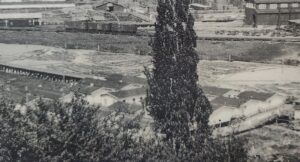
Ito Kawamoto had come to live in Tokyo Slough with her husband, Ichiro Kawamoto, who was the crew chief at the Pacific Spruce mill and hired by the company to assemble a group of mostly Japanese laborers. Ito Kawamoto was hired to cook for the crew. Both had lived in Oregon for more than 18 years.
That same morning, red handbills circulated around town announcing a rally. It read: “Mass meeting by the citizens of Lincoln County at the Toledo ballpark, 6 p.m. July 11. Purpose to decide the question now and forever as to whether we want our citizens replaced by Japanese, or other industries in this country,” according to a 1925 Lincoln County Leader newspaper article.
At the rally, speakers said the Japanese immigrants were taking their jobs and argued that their presence caused property values to drop.
Rosemary Schenck, the police chief’s wife, urged men to show up at the waterfront at 2 p.m. to do something about it. Rosemary Schenck was politically active and in 1932 was the failed Democratic candidate for the Oregon Senate.
Both she and her husband were not present at the riot, but their roles were instrumental in the effort to force Asian laborers from Toledo. Instead, they watched violence unfold from their house overlooking the mill.
The day after the rally, Asian workers were grabbed out of their homes by the mob. Some held rocks and sticks; at least one waved the American flag.
The mob had rocks in hand and were poised to hit mill owner C.D. Johnson with a stick if he didn’t let the group onto the property where the Japanese millworkers lived. Others watched from the street, jeering anti-Japanese sentiments.
The sheriff drew his gun to try to stop them, but a 15-year-old boy disarmed him and threw the weapon into the river. The scene devolved into a full riot as more than 50 people overpowered the sheriff and company leaders trying to block the entrance to Tokyo Slough.
Ito and Ichiro Kawamoto watched the riot unfold from the windows of their home. Then they heard the rocks and sticks rain down.
Martin Germer waved the American Flag fervently yelling “Get them all out!”
The men broke into the Kawamoto’s house with a wood battering ram and told the family to pack up and leave. When Ichiro Kawamoto stood his ground, they threatened to hang him up and kill him, knocking him to the ground before dragging him out of his home.
“I thought my husband and my children and I would be killed,” Ito Kawamoto said in her court testimony a year later.
The crowd cheered as the Tokyo Slough residents were forced from their homes, holding all the belongings they could gather. Twenty-two Japanese resident laborers, four Filipino employees, one Korean worker, two women and three Japanese-American children were loaded into cars and trucks and taken to Corvallis and put on a train to Portland.

Unprecedented trial
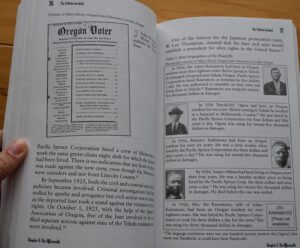
Through the Japanese Association of Oregon, Ichiro and Ito Kawamoto and three other Japanese laborers filed civil rights lawsuits against members of the white mob including the Schencks – and won. It was the first case of its kind to be tried in the United States.
Japanese mill worker Tamakichi Ogura’s lawsuit, seeking $25,000, led to the trial that unfolded one year after he was removed from Toledo.
Lawyers used the 1911 Treaty of Commerce and Navigation between Japan and the United States as the basis of their argument. This treaty guaranteed Japanese immigrants the right to reside and work within the U.S. under the protection of American law.
Defendants argued that they acted in a peaceful manner and that their actions had been misinterpreted. But some of their own evidence backfired against them.
A telegram sent by Rosemary Schenck that was entered into the record used phrases like “taken out of the county” and “taken to the depot”, showing the jury that the residents of Tokyo Slough did not leave voluntarily.
The trial lasted nine days, with the jury unanimously ruling the six defendants guilty of civil rights violations and awarding $2,500 damages plus court fees to Ogura.
The other four civil rights lawsuits were settled out of court later that year.
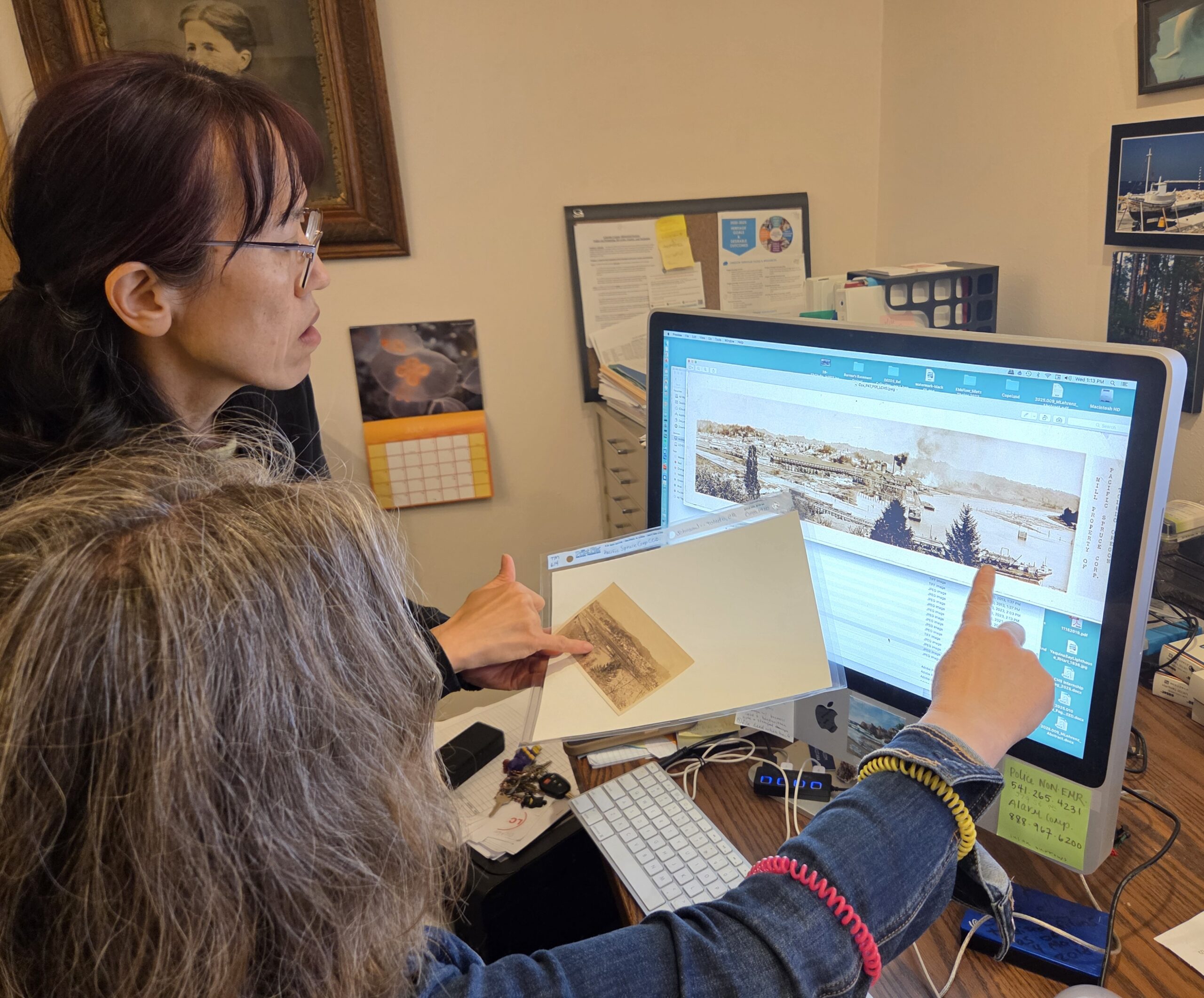
A century later
Lincoln County Historical Society curator Sachiko Otsuki shuffles through files and photographs in a dimly lit room in the organization’s Newport archives. Three boxes are filled with newspaper clippings and court records with notes in the margins – Cox’s notes and materials for writing the book.
There has been more acknowledgment of the event 100 years ago since Cox published his book. He toured Oregon and elsewhere to give presentations following the book’s release. In Portland, he met with the Kawamotos’ two children, Jane Hinatsu and George Kawamoto.
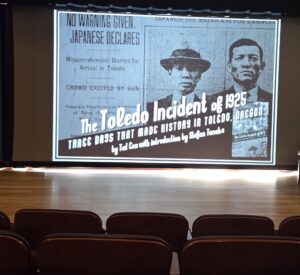
About three years ago, the Lincoln County Historical Society commissioned a short documentary that is available to view at its Pacific Maritime Center. The film includes interviews with Cox and Toledo descendants.
Since the book’s release, the city of Toledo also included information about the Toledo Incident on its website. Next year, the historical society plans to showcase multiculturalism in Lincoln County with an exhibit that includes the Toledo Incident.
Otsuki cautioned against viewing the Toledo Incident as a singular event. What it really was, was one element in a repeating pattern.
“There is repetition of this exclusion of immigrants,” Otsuki said.
In 1886, about 50 Chinese millworkers in Oregon City were dragged from their beds in the middle of the night and forced to board a steamboat to Portland. In the 1870s Chinese laborers were encouraged to work in Oregon canneries, many along the coast and in Astoria. The laborers filled gaps in the need for workers.
First, there is often a need to find immigrants to work a tedious or difficult job in mills or farms or canneries, Otsuki told the Lincoln Chronicle. Then, after a while, immigrants are often met with vitriol and exclusion.
“The targets may be different, but it’s the same thing happening again and again,” Otsuki said.
- Shayla Escudero covers Lincoln County government, education, Newport, housing and social services for Lincoln Chronicle and can be reached at Shayla@LincolnChronicle.org





















I have read this book. I am glad I did. I do realize a lot of that was going on at the time but never expected it here in Oregon. Especially in the small town of Toledo. I have noticed that the book got bad reviews. I think it was due to the fact that people just simply don’t want to beleive it happened. But it did, and it was wrong, so wrong. Read the book.
Thank you for publishing this historical story. May none of us ever experience divisive hatred again. Blessings to all, Katrina
I am so happy that our history is accurately presented, no matter how uncomfortable it may make us feel. In the end, this will make us a stronger, fairer society.
I have this book and have loaned it to several people who were also shocked that this could happen in Toledo. I also recognized a few prominent family names, some who appear as street names today, who had involvement in this horrible event
Having lived and worked in a number of countries, I realize the unique part of American culture is that history is not written mostly by the “victors”. Our writers and historians are free to present the darkest moments in our history as this book does. The omission they often make, however, is the context of the period. The racial and economic prejudices of the late 1800s and early 20th centuries were common across the world, including the Armenian genocide, the Ottoman domination of the Middle East, and not to mention Chinese-English conflicts, the bloody mayhem between Muslims and Hindus in India, Japanese slaughter of Chinese, Russian slaughter of Jews. What is also unique about the Toledo incident is that apparently no one was killed and the victims used our judicial system rather than violence for redress of wrongs. Your article says, “Cox and historians say it’s a repeating pattern.” Where? Sure, we have people who object to new immigrants, but has anything like the Toledo incident taken place in Oregon or the US? We may have strong feelings about how ICE and other agencies are handling immigrant issues, but where are mobs of citizens driving immigrants out of their homes?
Excellent review with also reminding readers not to rush to generalize the negative illegal immigration as a repeat of 1925 in Toledo. Citizens of Lincoln County are not vigilantes in 2025. There is a big difference between legal and illegal presence in the U.S. Thanks for documenting another viewpoint on local history.
I agree with you 100%. This is an amazing history book, because it is based on facts and the truth. The mob was started by the Chief’s wife, Rosemary Schenck, whom was a progressive Democrat. The Governor, Walter Pierce, was also a progressive Democrat, who was backed by the Ku Klux Klan, and he created the Oregon alien property act of 1923, which prohibited aliens from owning, or leasing Oregon land. The closest this book comes to anything happening today is the Portland riots, which was caused by the same group.
The article reports on a hundred year old event. Lincoln Chronicle adds to the description “that it is repeating itself in the USA again”. Can the Chronicle cite some recent cases where mobs of angry citizens forcefully evict minorities because they have taken their jobs? Or are you in some half-baked logic equating enforcement of established US law with mob rule? Notice that the Toledo actions were illegal and subsequently remediated by the court. Where is that happening now?
Let’s start with every single Native American “reservation” here in the United States, yeah?
I think they are still happening now?
I don’t see anything happening here today in the United States that is similar to the Toledo incident. Hopefully, the Lincoln Chronicle is not referring to our federal government trying to deal with the tens of millions of illegal aliens who have simply walked into our country without any sort of vetting in recent years.
Today we have masked federal agents with no name tags or badge numbers snatching people off the street and into unmarked vehicles and sending them to distant detention centers and sometimes foreign countries. Echoes of 1930s Germany.
Anybody who fails to see the similarities with historic events is either uninformed or willfully misinformed.
All the Immigrant bashers seem to forget that many of the immigrants present in this country were allowed in because of asylum rules, student visas, temporary protected status or other legal means of waiting to have their cases heard.
Further, this country was built by immigrants, documented and not documented, and every wave was greeted with the kind of bigotry and discrimination we see today. The Irish, the Italians, the Germans, the Jews, the Chinese — all faced discrimination and bigotry when they entered this country.
What federal government is doing now is immoral and inexcusable and will erode respect for federal law enforcement for years to come.
We are a country of laws. Immigrants have a legal way to enter the country. If you are here illegally then you are subject to deportation it very simple. What is happening today is brought on by the Immigrants themselves. No one else is responsible.
Surprised The Brown Round-up letter recently circulated throughout Lincoln County was not mentioned to provide some current context and the important reminder that history repeats itself. And still we don’t learn.
There’s been an increase in harassement, etc., towards Asian Americans in Oregon. https://oregoncapitalchronicle.com/briefs/survey-finds-many-asian-oregonians-experience-hate-crimes-harassment-that-go-unreported/ As the article indicates, many aren’t reported so the actual number of incidents is likely to be greater. The article doesn’t indicate how much of the harassment occurs in workplaces.
I agree it’s important to read well researched histories of the US, to be aware of the good & bad–although clearly there’s disagreement about how “good” & “bad” are defined.